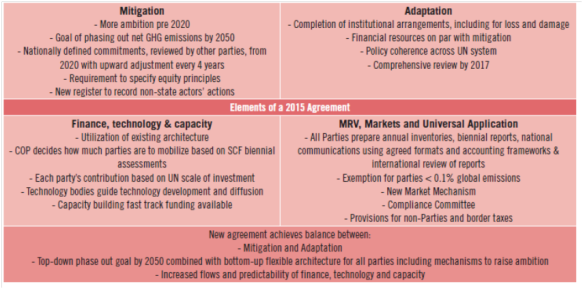Is it feasible to have zero greenhouse gas emissions by 2050? Yes!
WHO: Niklas Höhne, Pieter van Breevoort, Yvonne Deng, Julia Larkin, Gesine Hänsel (ECOFYS Consultants, Köln, Germany)
WHAT: Looking at the technical and economic feasibility of having zero greenhouse gas emissions by 2050
WHEN: 2 October 2013
WHERE: On the ECOFYS website
TITLE: Feasibility of GHG emissions phase-out by mid-century (open access)
Is it technologically and economically doable to have zero carbon emissions by 2050 so that we can avoid an unlivable climate? Yes! Huzzah – easiest and shortest blog post ever. Let’s have a glass of wine and go home.
For those of you that don’t just want the tl;dr version, here are the details. The German environmental consulting firm ECOFYS set out to find out if it was doable to have zero GHG emissions by 2050 and it is.
It’s going to take some serious restructuring of how we do things and the systems we use, but we can get 90% of the way there with current technologies and it will cost around 5% of a country’s annual GDP each year.
If that sounds like a lot of money (which it is), consider that the globe currently spends around 3% of annual GDP subsidising fossil fuel production each year. So if we removed fossil fuel subsidies and made them compete on a level playing field with renewable energy, it will practically be cheap!
The authors of the paper also point out that while that’s what the estimated costs are now, the longer we wait to get going on reducing emissions the more expensive it is (and that’s before the billions of dollars extreme weather disaster clean ups cost get factored in).
Ok, so restructuring – what exactly does that entail? It involves changes to the systems that we use to do things. The first big one is energy systems, which account for two thirds of our fossil fuel emissions and the first change that takes a big chunk out of our emissions is electrification.
Because there is no ‘silver bullet’ material to replace oil, moving things that use oil over to electricity makes it easier to decarbonise, because you can take a hybrid-renewable electric grid and feed lots of different kinds of power into it.
Industry and industrial systems account for 30% of the world’s carbon pollution. The fastest way to decarbonise those is through circular manufacturing processes that reuse and recycle 100% of their inputs, which is already being worked on at the Ellen MacArthur foundation. We will also need to be more efficient with things like co-generation where you use waste heat (like the heat in your shower water when it goes down the drain) to heat buildings.
These ideas will get industry about 95% of the way off our carbon habit, so the gap will need to be closed with some extra innovation before 2050, which I’m sure humanity is capable of.
Buildings are about 20% of the world’s carbon emissions. The way to decarbonise the existing buildings is to retrofit them to high efficiency standards. In order to do this by 2050, we’ll need to be renovating existing building stock at a rate of 2-3% each year (which the authors say has been demonstrated as an achievable rate).
Because buildings have a long lifespan of decades, the other really important thing is to make sure there are new building standards where all new buildings need to be as close to carbon zero as possible and powered by zero emission sources.
The other areas buildings can be more efficient is to make sure they’ve got efficient appliances in them, and efficient stoves which reduces black carbon (soot) pollution.
What about transport? It accounts for about 15% of global emissions, and one of the first things we can do to make transport less carbon intensive is to have better Urban Planning. Good news – when you have walkable and bikeable urban areas people drive less and take public transport more often!
All vehicles will need better efficiency standards – all road vehicles, rail transport, air transport and shipping. Passenger and freight transport needs to be switched to zero carbon options.
Here’s the bit I really like – 100% electrification of individual road transport and rail transport. Think of how much nicer cities will be to walk around when they’re full of electric cars! No more nasty noisy traffic, because the internal combustion engine is last century’s technology and hot cars like a Tesla are the future.
For the transport that cannot be electrified like international shipping and air travel, advances in biofuels will get us there by 2050.
Power supply covers about 5% of global emissions, but coal power plants are nasty, dirty, toxic things. So naturally the first step there is to rule that any new power plants get built with carbon capture and storage or not at all. Carbon capture and storage will also be important for biomass, but interestingly, the paper says that nuclear power is not essential for electricity generation.
What is essential for electricity decarbonisation is smart grids. We need a more efficient electrical grid, and unless we know how much power people are using, we can’t meet demand at the times they need it.
Agriculture contributes 25% of global greenhouse gas emissions (and it’s not just from cow fart methane either). The first thing that needs to happen is the end of deforestation. Cutting down trees means not only that the carbon gets released from the tree, but also that tree is no longer in service sucking in carbon dioxide and giving us back oxygen. We really need trees on the job of sucking up carbon, so we need to stop cutting them down.
Next we need to enhance the amount of carbon sequestered in soils. There’s a whole heap of new farming techniques that help keep moisture in the soil and retain the nutrients to reduce inorganic fertilizer use, so keep up the good work farmers!
Next, us city people need to stop wasting so much food. It’s estimated at 40% of the food produced globally gets wasted. So we need to stop doing that and stop putting food scraps into landfill where it produces methane. Start composting, people.
Another suggestion the paper had was to make sure all wastewater (the water you flush) gets treated with anaerobic digestion, so the methane can be collected and used to heat things.
With a long list like that it sounds expensive, right? It will be. But you know what’s going to be more expensive? Doing nothing. Business as usual will force us to pay huge amounts to adapt to continued and diversifying climate disasters, which will cost anywhere between 5-20% of global GDP every year depending on how unlucky you are. You could get ‘lucky’ and only have to clean up from an extreme weather event once a year, or you could get unlucky and have drought followed by floods, followed by a storm, followed by weird snow, unprecedented forest fires, etc. The list is scary, long and very, very expensive.
So what do we need to do to make all of this start steamrolling forward? We need a price on carbon. The paper used an estimated price of US$50/tonne, and it makes a lot of sense that if you no longer allow everyone to use the atmosphere as a free pollution dump, then innovation and changes will kick in pretty quickly after that.
So how ‘bout it? Shall we price carbon, stop burning it and make our cities and homes healthier places to live?










